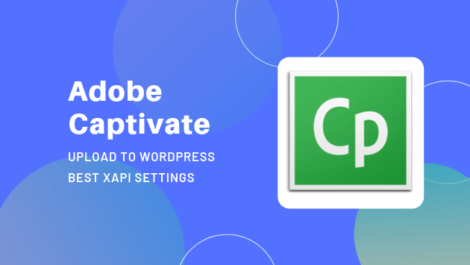

Turning on reportingįirst, let’s turn on reporting. This is where we decide which information we want to be sent to the LMS by the xAPI course. The reporting section is where most of our focus will be. Step 1: Choose PreferencesĬlick on ‘Adobe Captivate’ in the menu and then ‘preferences’. For the purpose of simplicity, let’s use these interchangeably. Note* Adobe still refers to xAPI by its project name, Tin Can. In this article, we walk you through the Adobe Captivate xAPI publishing process. In fact, with Adobe Captivate, the process is pretty much the same as the one to publish SCORM content. Republishing your SCORM content in xAPI is a prudent move to reduce problems that can happen with the older standard.Īnd the good news is – xAPI is easy to create. Even if you don’t have the opportunity to take advantage of the wider functionality that xAPI provides, it’s a better, more stable standard to use than SCORM.
#Adobe captivate scorm zip
Add a SCORM module and upload this SCORM zip folder.We love xAPI. You’re ready to upload your project to the LMS.
#Adobe captivate scorm download
Change the location for download (e.g.On the main toolbar, click Publish > Publish for Devices (for responsive projects) or Publish > Publish to Computer (for non-responsive projects).When you have finished applying these settings, you are ready to publish your course. Review the scoring, slide duration and styling options before moving on to the publishing stage. We recommend using this setting to get more granular data for your reports. Send details of any interactions your user makes with the SCORM back to your LMS, such as the total time spent on the course. There are two options, Percentage or Points format. This section dictates what data is sent back to your LMS and in what format. If you choose Quiz, and Quiz is Passed or Quiz attempt limit is reached from the drop-down, you must also choose the Status Representation of Incomplete - Pass/Fail. We recommend that if using User Access, you choose that the learner views 100% of your slides.Ĭhoose that a learner is set to complete when they view your slides and/or when they have passed the Quiz. You can edit the percentage of slides or refine it to a certain number of slides before they are marked 'Complete'. You can choose how many of your slides a learner needs to access by editing the Slide Views. The user can complete by simply accessing the course and/or the Quiz if you have one. This section decides how the LMS knows if a user has passed the course. To determine whether a user passes or fails, please ensure you have a passing score set on the SCORM. The SCORM will report back the scores obtained and whether the user passed or failed the exam to your LMS. This option must be used when the course contains an exam. Once a learner meets the SCORM success completion criteria, they're marked as complete. This option is for SCORM courses that don't have an exam. The sections answers the questions- When has a course been completed? And how is this communicated to your LMS? There are two options to choose from: Choose the option your LMS supports from the drop-down list. Standard: The ‘standard’ is the version that your SCORM file will be published in.If your LMS is not on the list choose Other Standard LMSs. LMS: This option allows you to choose an LMS to distribute your content.

You can see the options: LMS and Standard. To enable the reporting features, click the option Reporting located in the section Quiz.Įnable the option, Enable reporting for this project. In Preferences, you can see a list of options. See this document for more information on the LMS options.Īfter you create a course, here are the steps to create a SCORM package. Adobe Captivate's features allow simple SCORM activities like completion status, quiz results, and scoring. And that includes creating SCORM-compliant courses.

One of the benefits of Adobe Captivate is that you can develop and publish eLearning courses faster.


 0 kommentar(er)
0 kommentar(er)
